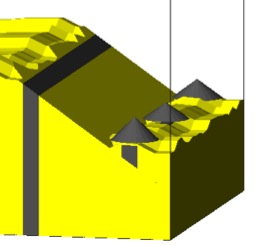
Relative geologic time asks you to use very fundamental principles of geology (horizontally, superposition, cross-cutting relationships, intrusive relationships, etc.) to solve a puzzle. Because the GTM uses a symbolic way of representing the effects of geologic processes, it may initially not be clear what some of the 3D graphics mean. Here are some hints:
-
1.The yellow material is always the “beginning” rock layer:
-
2.Sedimentation is represented by the red layer. If sedimentation is the "newest" process you will see water on top. Sedimentation produces a flat upper surface - if the top of the red layer is not flat, then it has been affected by another subsequent process!
-
3.Erosion is represented by grooved surfaces.
-
4.Faulting in GTM is always normal faulting which offsets features along a initially smooth fault plane.
-
5.Faulting followed by erosion will erode the fault plane as well.
-
6.Volcanoes are represented by cones fed by a feeder dike. If faulting occurs after the volcanoes, the fault plane will cut across the dike
-
7.If erosion follows the volcanoes, the volcanic cones will be gone and only a grooved dike will be visible.
-
8.If sedimentation follows the volcanoes, the volcanic cones will simply be buried without any change to their shape - these cones will only be visible in “Transparent” mode!














Homepage